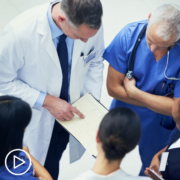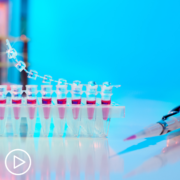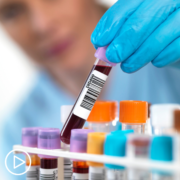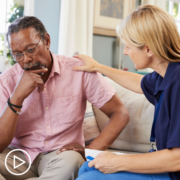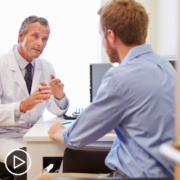See More From The Pro-Active AML Patient Toolki
Related Resources:
Transcript:
Katherine:
So, in looking at a treatment plan, we’ve discussed the factors that go into that choice. And then, you’ve also just covered some treatment approaches and who they might be right for. So, you’ve talked about chemotherapy. You’ve talked about stem cell transplant. What about targeted therapies and also clinical trials? Where do they fit in?
Dr. Desai:
Right now, if somebody’s diagnosed with new AML or newly diagnosed leukemia, and they are eligible for intensive chemotherapy of the approved agents, the one targeted therapy that does make a difference is midostaurin, which is a FLT3 inhibitor.
And patients who do have a FLT3 mutated leukemia, the standard of care is treatment with intensive chemotherapy in combination with midostaurin. So, this is where chemotherapy’s combined with the backbone of the targeted therapy.
There are clinical trials of other targeted therapies that are being combined with frontline treatment. That frontline treatment might be intensive chemotherapy or more of the hypomethylating-based therapy, which is what we call lower intensity therapy. So, these are where the clinical trials are asking the question that can be just how midostaurin was combined with chemotherapy.
Can we combine other targeted therapies with the backbones that currently exist? Chemotherapy or lower intensity hypomethylating agents. And can we combine them to improve the chances of going into remission and staying in remission?
I would say clinical trials are extremely important. Almost any stage of leukemia, whether it’s a new diagnosis, whether it’s second-line or relapse, it’s important, because these questions that are being asked are very relevant. How do we improve upon the existing known remission rates and survival in leukemia?
There are targeted therapies available for IDH inhibitors that are being combined. There is also a newly approved BCL2 inhibitor, venetoclax, which is used in combination with hypomethylating agents, that have shown survival advantage over single agent.
Hypomethylating agents, anybody who’s older, we are now combining the venetoclax with hypomethylating agents for what we call lower intensity induction treatment. And there are several others in the making. We have TP53 inhibitors.
As we talked about this, that leukemia is not one diagnosis, really. AML has several, several, several subtypes, and once we find out what makes that particular patient’s leukemia tick, and if you have a targeted inhibitor towards it, it’s logical that you would want to combine it with what the backbone of treatment is, and that’s where clinical trials are extremely important in asking most relevant questions and improving patient survival.
Katherine:
Dr. Desai, I learned that oral azacitidine was recently FDA approved. What does that approval mean for patients and who is it right for?
Dr. Desai:
So, oral… So, azacitidine. For patients who may or may not know this, azacitidine has been approved in the IV or subcutaneous formulation for treatment of myelodysplastic syndrome and leukemia.
And this is, when I was saying that there is a lower intensity treatment of hypomethylating agents, that’s one of the drugs, azacitidine. And we use it for induction treatment in patients who do not qualify for intensive chemotherapy in AML.
So, oral azacitidine has been currently approved for older patients who have gone through intensive chemotherapy.
The trial was done in patients who did not have prior hypomethylating exposure of any kind, so people who had not seen any IV or subcutaneous azacitidine, they had leukemia, they get the intensive chemotherapy, finish the induction part, and the, what we call, consolidation part, which is the cleaning up with more additional cycles of chemotherapy.
Once that is done, the old standard of care was to not do anything, so these are obviously for patients who are not transplanted. So, once somebody, just to give a background on this, if somebody’s in remission and they’re transplant eligible, we make a decision whether they should go for transplant or they should get some more chemotherapy rounds. Both are consolidation of some kind, transplant or chemotherapy.
So, let’s say somebody went through induction, got into remission, and it was decided that they’re not candidates for transplant, or the patient didn’t want to go through a transplant, and you go for the consolidation. And the old standard was, after that, to do nothing. And oral azacitidine was tested in this situation, where half the patients got oral azacitidine as maintenance. It was given as pills, to take it for two weeks out of a 28-day cycle.
So, every month, you take it for 14 days. And half of them didn’t get the drug, oral azacitidine. And the drug was recently approved for FDA for having a survival advantage over the standard of care, which is to do nothing after consolidation is over.
So, in other words, this is currently available for patients, older patients, who’ve gone through induction chemotherapy, and/or consolidation, and then finished it. Then, you start this oral azacitidine for keeping this remission going on longer. And that’s where the niche of this drug is.
It is very, very important to understand that oral azacitidine has a very different kinetic in the body than IV azacitidine. So, I think people, many times, get confused between is IV the same as oral? They are totally different drugs and have a different way it affects the bone marrow.
So, they’re not to be interchanged for that indication. Oral azacitidine has been strictly approved for maintenance of remission, post-chemotherapy.




